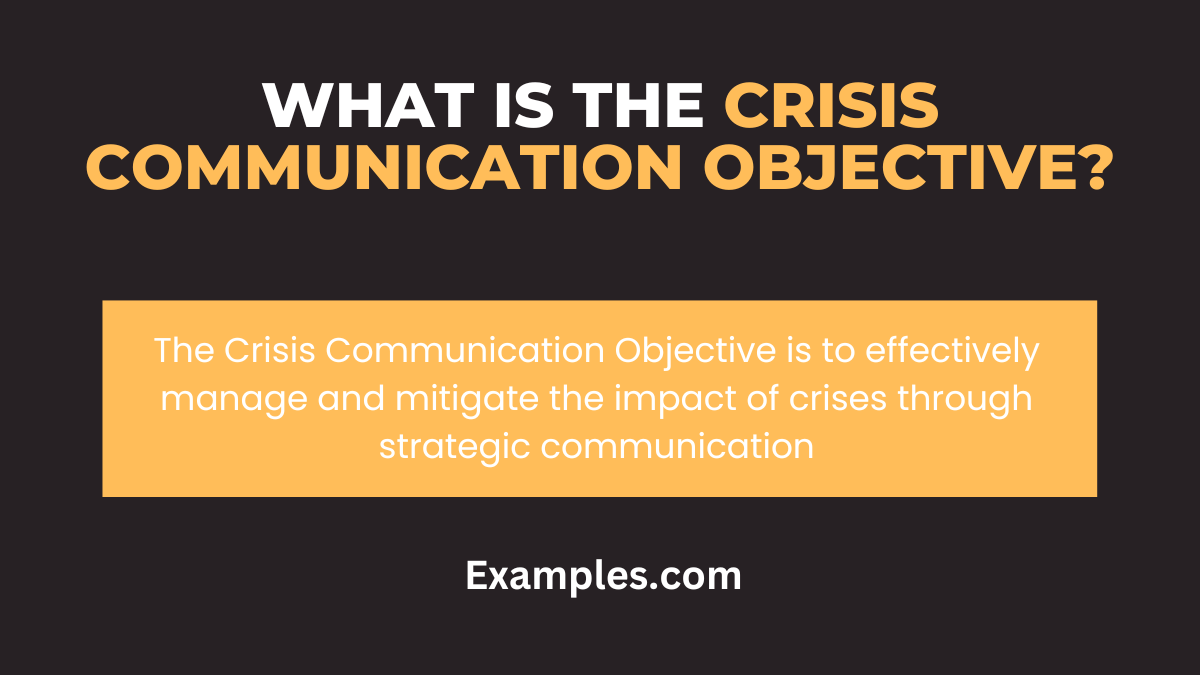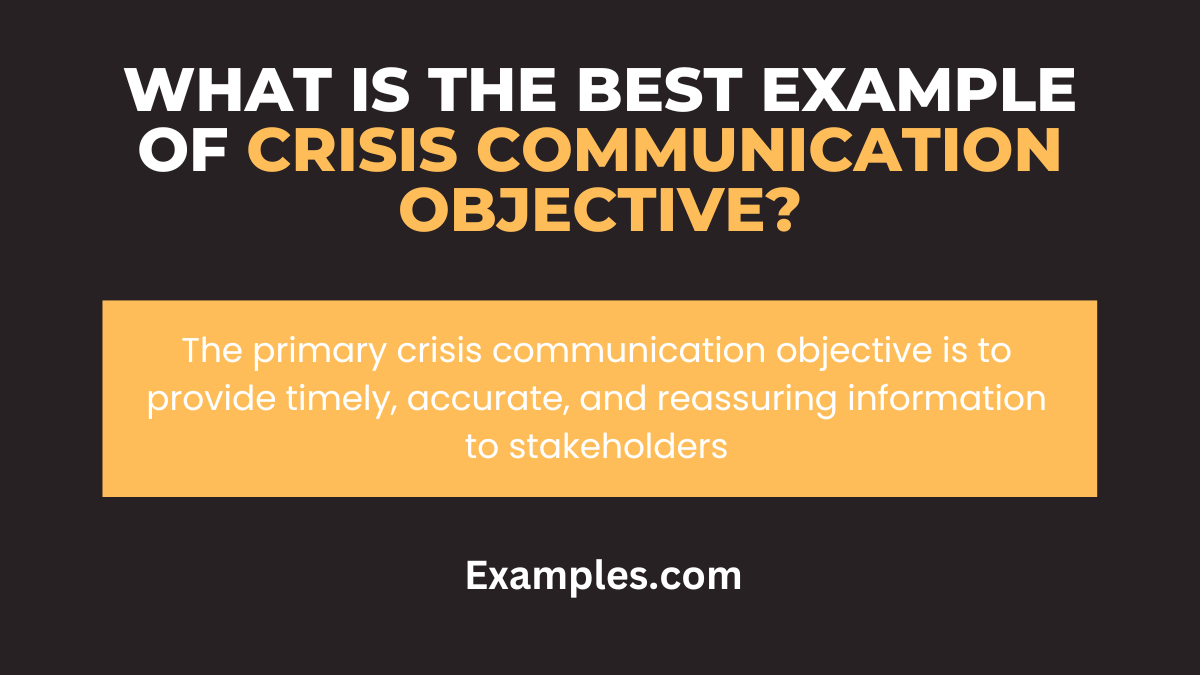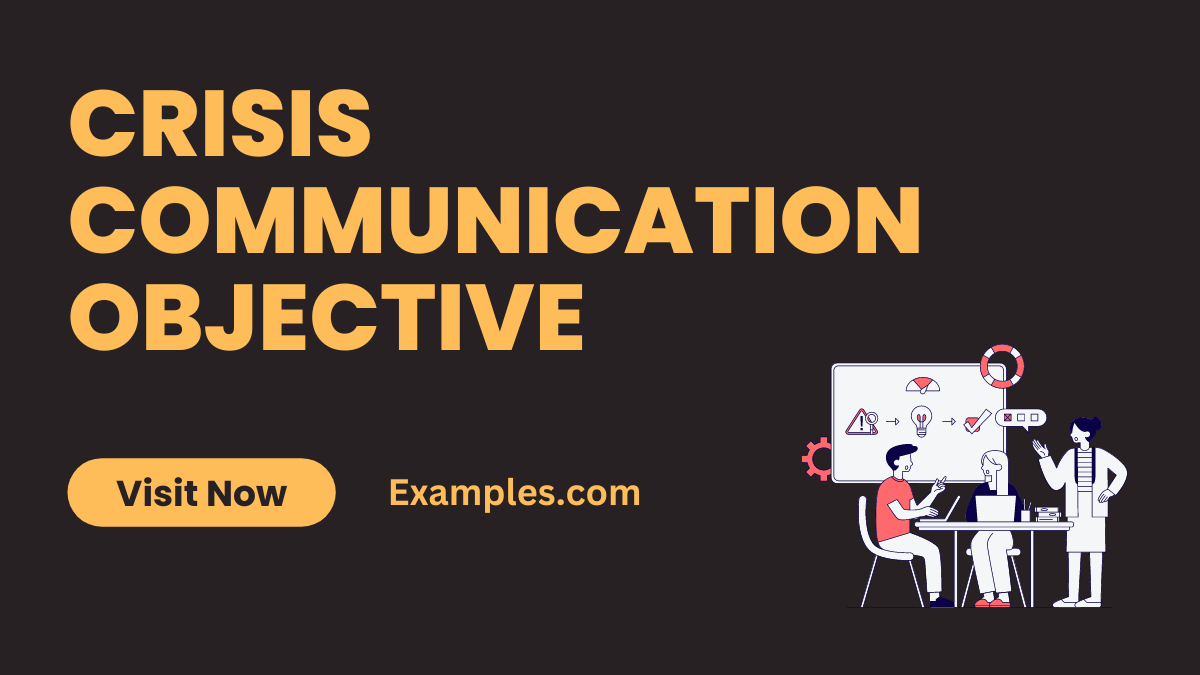19+ Crisis Communication Objective Examples
In today’s fast-paced world, where information spreads rapidly, understanding the Crisis Communication Objective is more crucial than ever. This complete guide delves into the essence of effective crisis communication, exploring strategies to convey messages clearly and manage public perception during challenging times. By mastering these objectives, organizations can not only navigate through crises but also emerge stronger and more resilient.
What is the Crisis Communication Objective?

The Crisis Communication Objective focuses on maintaining and restoring an organization’s reputation during crises. It involves strategic messaging to inform, reassure, and engage stakeholders, ensuring transparency and trust throughout the crisis lifecycle.
What is the Best Example of Crisis Communication Objective?

A prime example is a company swiftly addressing a product recall with transparency and empathy, reassuring customers, stakeholders, and the public about the steps being taken to resolve the issue and prevent future occurrences.
20 Examples of Crisis Communication Objective

Crisis communication objectives are essential in managing and mitigating the impact of a crisis effectively. These objectives focus on maintaining transparency, trust, and stability, ensuring that accurate and timely information is communicated to the appropriate audiences. They are crucial for reputation management, stakeholder reassurance, and guiding an organization through challenging times.
- Rapid Response Activation: Quickly mobilizing a communication team at the onset of a crisis.
Example: “Activate the crisis team immediately to assess the situation.” - Accurate Information Dissemination: Ensuring that all communicated information is accurate and verified.
Example: “Cross-check all facts before releasing any statements.” - Consistent Messaging: Maintaining a consistent message across all channels.
Example: “Ensure all departments are aligned with the central message.” - Stakeholder Reassurance: Reassuring stakeholders about steps taken to manage the crisis.
Example: “Communicate our action plan clearly to all stakeholders.” - Transparency in Communication: Being transparent about the crisis and its impacts.
Example: “Share what is known and what is being done.” - Media Management: Effectively managing media relations to control the narrative.
Example: “Provide regular updates to the media to maintain a clear narrative.” - Internal Communication Strengthening: Keeping internal teams informed and engaged.
Example: “Update employees regularly to keep them informed and involved.” - Customer Trust Maintenance: Maintaining trust with customers through honest communication. Example: “Address customer concerns directly and honestly.”
- Crisis Escalation Prevention: Preventing escalation through strategic communication.
Example: “Monitor feedback and respond swiftly to prevent misinformation spread.” - Empathetic Tone Adoption: Communicating with empathy and understanding.
Example: “Address the affected parties with care and empathy in our messages.” - Regulatory Compliance Assurance: Ensuring all communication complies with legal requirements. Example: “Review all public statements for legal compliance.”
- Feedback Monitoring and Response: Actively monitoring and responding to feedback.
Example: “Set up a team to monitor social media and respond appropriately.” - Reputation Management: Managing and protecting the organization’s reputation.
Example: “Highlight positive steps taken to mitigate the crisis.” - Post-Crisis Analysis: Analyzing communication effectiveness after the crisis.
Example: “Conduct a debrief to evaluate our communication effectiveness.” - Continuity Plan Communication: Communicating the business continuity plan effectively.
Example: “Clearly communicate how business operations will continue during the crisis.” - Crisis Impact Minimization: Aiming to minimize the impact of the crisis.
Example: “Focus on communicating solutions and progress in addressing the crisis.” - Restoring Normalcy: Focusing on communication that helps restore normal operations.
Example: “Communicate steps taken towards returning to normalcy.” - Long-Term Strategy Communication: Developing long-term communication strategies post-crisis. Example: “Plan for long-term communication to rebuild confidence.”
- Public Safety Information Dissemination: Ensuring public safety information is communicated effectively.
Example: “Prioritize sharing of safety information to the public.” - Leadership Visibility Enhancement: Enhancing the visibility of leadership during the crisis.
Example: “Have our leaders take the forefront in crisis communication.”
What is the Primary Purpose of Crisis Communication Objectives?
- Rapid Response and Clarity: Ensures timely and clear communication during a crisis to manage the situation effectively.
- Maintaining Public Trust: Aims to preserve or restore trust in the organization among stakeholders and the public.
- Minimizing Misinformation: Focuses on combating rumors and misinformation by providing accurate and verified information.
- Reputation Management: Protects and salvages the organization’s reputation during and after a crisis.
- Ensuring Consistent Messaging: Ensures all communications are consistent and aligned with the organization’s values and message.
- Stakeholder Engagement: Keeps stakeholders informed and engaged to maintain confidence and support.
Importance of Crisis Communication Objectives
- Preparedness for Unexpected Situations: Enhances the organization’s readiness to handle unexpected crises.
- Damage Control: Helps in mitigating the potential damage a crisis can cause to the organization.
- Regulatory Compliance: Ensures communication aligns with legal and regulatory requirements during a crisis.
- Employee Assurance: Provides clear guidance to employees, reducing panic and confusion.
- Customer and Public Safety: Prioritizes the safety and well-being of customers and the public.
- Long-Term Viability: Contributes to the long-term stability and viability of the organization post-crisis.
Crisis Communication Objective Goals
- Quick and Accurate Information Dissemination: Prioritizes rapid dissemination of accurate information.
- Preserving Organizational Image: Focuses on maintaining a positive image of the organization.
- Effective Stakeholder Communication: Aims to communicate effectively with all stakeholders.
- Continuity Planning: Ensures business continuity and minimal disruption.
- Learning and Adaptation: Involves learning from the crisis to improve future responses.
- Transparency and Honesty: Emphasizes transparent and honest communication throughout the crisis.
Crisis Communication Objectives in Business
- Business Stability: Aims to maintain stability and continuity in business operations.
- Investor Confidence: Seeks to retain the confidence of investors and financial markets.
- Brand Protection: Focuses on protecting the brand identity and equity.
- Customer Retention: Aims to retain customers by ensuring timely and empathetic communication.
- Market Position: Strives to maintain or restore the organization’s position in the market.
- Adaptive Strategy Implementation: Incorporates flexible strategies to adapt to evolving crisis situations.
Effective crisis communication is vital for navigating challenging situations. To craft a compelling crisis communication plan, follow these tips and guidelines. Remember, clear, empathetic, and timely communication can help you manage crises, maintain trust, and protect your reputation.



